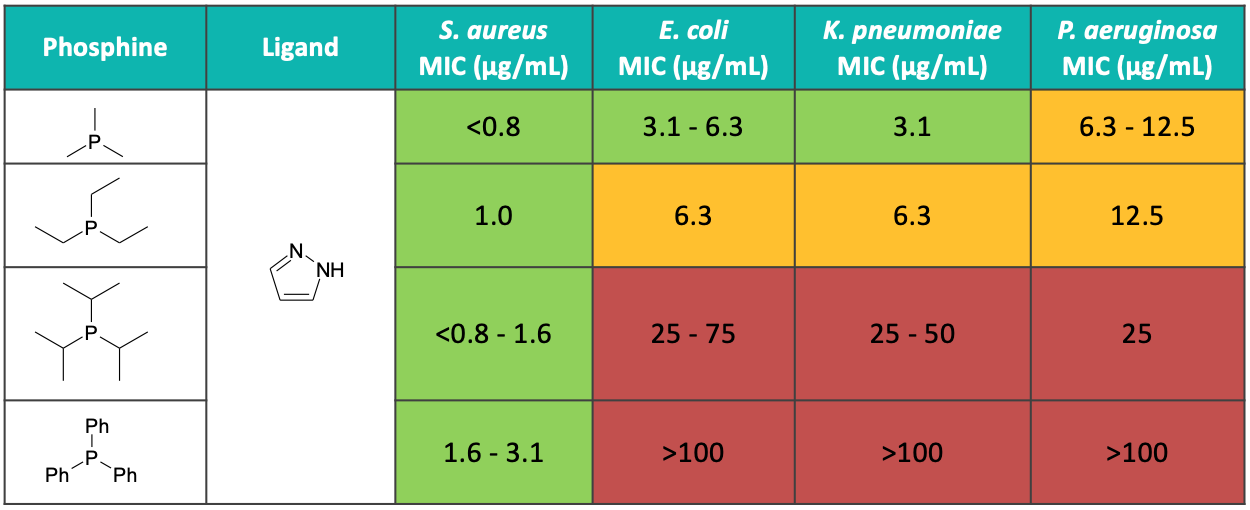- About
-
Solutions
-
Services
- Biosciences
- Chemistry
- Integrated Drug Discovery
- Computer Aided Drug Design
- Hit Identification
- Target Classes and Modalities
- Therapeutic Areas
-
A-Z
- A
- B
- C
- D
- E
- F
- G
- H
- I
- K
- L
- M
- N
- O
- P
- R
- S
- T
- V
- X
-
Services
- Library
- News & Events
- Careers
Gram-Negative Antibiotics: A Drug Discovery Case Study
A new class of potential anti-infective drugs
Domainex helped develop a novel class of gold(I) antibiotics, with a broad spectrum antibacterial activity against the so-called ESKAPE pathogens.
Challenge
Bacteria are becoming increasingly resistant to many existing antibiotics and the spread of drug-resistant bacteria has become a significant issue. It is estimated that 50–60% of hospital-acquired infections (HAIs) in the U.S. are caused by antibiotic-resistant bacteria1, including the so-called ESKAPE pathogens (E. faecium,S. aureus,K. pneumoniae, A. baumannii, P. aeruginosa and Enterobacter Spp). The discovery and development of new antibiotics has slowed in recent decades and no novel class of antibiotic has been brought to the market in over 30 years. The World Health Organisation (WHO) has stated that humanity is facing the prospect of returning to a pre-antibiotic era in which common infections and minor injuries could be lethal.2 There is consequently a significant need for new antibacterial agents, especially against Gram-negative bacteria.
Solution
Domainex was commissioned to develop a novel class of gold(I) antibiotics, with broad-spectrum antibacterial activity against the ESKAPE pathogens.
Hit identification
Following phenotypic screening of a library of FDA-approved drugs, auranofin, a second generation chrysotherapy agent, was identified as having activity against Gram-positive bacteria. Auranofin is a linear, 2-coordinate gold complex which was approved for the treatment of rheumatoid arthritis as a disease-modifying antirheumatic drug (DMARD) in 1985.
Assay development
Metal complexes have intrinsic reactivities essential to their biological effect, which adds complexity to in vitro and in vivo profiling. Domainex’s analytical team successfully developed an extensive range of novel in vitro assays for triaging gold(I) complexes and established novel analytical methods for the analysis of surrogate markers of parent complexes in vivo.
Lead Optimisation
Three key areas of the auranofin structure were investigated during structure activity relationship (SAR) studies: linker (X), ligand (R) and the phosphine group (see Figure 1). Early findings indicated that both gold and phosphine were required for antibacterial activity.

The phosphines were extensively investigated with their size and lipophilicity shown to have a critical role in determining activity against Gram-negative pathogens. The most active phosphines sit within a defined physicochemical space, which Domainex medicinal chemists were able to explore and refine as part of the optimisation process.
In combination with an optimal phosphine, a variety of linker (X) and ligand (R) combinations were shown to be well tolerated and to exhibit broad-spectrum activity.

Due to their inherent instability and volatility, synthesis of lower alkyl phosphines is not trivial. However, chemists at Domainex were able to successfully develop robust and scalable routes to provide access to novel phosphine ligands. The syntheses of each chemical series proceeded via a common gold(I) chloride intermediate and could also be conducted on multi-gram scale with great success.
Conclusions
A novel class of gold(I) antibiotics was developed, with broad-spectrum activity against the so-called ESKAPE pathogens. Three distinct chemical series were identified, and the specific structure of the phosphine ligand proven to be a critical determinant of Gram-negative activity. Following systemic dosing in rodents, compounds showed activity in plasma and urine ex-vivo bioassays.
Five patents3-7 have been filed with Domainex scientists named as inventors.
Domainex Expertise
• Assay Development • Analytical Chemistry • Lead Optimisation • Medicinal and Synthetic Chemistry • Anti-infectives
References
- Centers for Disease Control and Prevention, Healthcare-associated Infections: https://www.cdc.gov/healthcare-associated-infections/php/data/?CDC_AAref_Val=https://www.cdc.gov/hai/data/portal/index.html
- World Health Organization, Antimicrobial Resistance: Global Report on Surveillance, 2014, http://apps.who.int/iris/bitstream/10665/112642/1/9789241564748_eng.pdf
- Gold (I) phosphine compounds as antibacterial agents, WO 2015/181550
- Gold (I) phosphine compounds as antibacterial agents, WO 2015/181551
- Anti-bacterial compounds, WO 2017/093543
- Alkynyl phosphine gold complexes for treating bacterial infections, WO 2017/093544
- Anti-bacterial compounds based on amino-gold phosphine complexes, WO 2017/093545